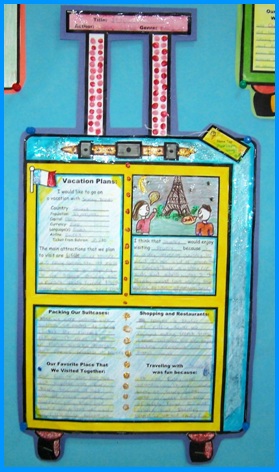Children live in a visual world and the ability to read visual images is becoming a vital skill. ‘Young people learn more than half of what they know from visual information’. Visual literacy is an
excellent teaching medium for visual and kinaesthetic learners, it supports EAL children in understanding, it is very effective for developing boys’ writing and it deepens children’s understanding of texts.
What will we obtain by using this strategy?
- An increased quantity and quality of writing
- A wider use of vocabulary
- A greater use of imagery
- An increased fluency
- More adventurous writing
- An improved attitude to writing due to improved motivation, self-esteem and enthusiasm.
What can we use and how?
Real-life pictures – Consider if there are any pictures that you can share with the pupils to exemplify stories from your life. Can pupils bring pictures in and share a story? This exercise could be linked to drama, role play and speaking and listening. Activities could include a two-minute discussion about a picture using some question prompts.
Describing pictures – Using a picture describe the scene to the pupils. Pupils can then use the description to sketch the picture on a blank A4 sheet. Show the children the picture and ask them to compare with their version. How close was their picture to the real thing? What mistakes had they made? Question the pupils about the picture. Is it a photograph? If not, how was it made? When was it made? What is happening in the picture? Is it a celebration – if so, what are they celebrating? Whereabouts are they? What time of year is it? Allow the children to guide the direction of the discussion.
 Film and television images – Use a visual image from a favourite film/TV programme to develop noun phrases. Give the pupils an A4 copy of an image and ask them to label the picture. Add adjectives to describe the nouns in different colours.
Film and television images – Use a visual image from a favourite film/TV programme to develop noun phrases. Give the pupils an A4 copy of an image and ask them to label the picture. Add adjectives to describe the nouns in different colours.

 Hidden images – Use pieces of card to mask the majority of a picture or photograph. Leave a small section of the image uncovered. Ask the pupils what they think is happening in the picture/photograph. As more pieces of card are removed, ideas need to be remodelled and this will be a catalyst for interesting discussions.
Hidden images – Use pieces of card to mask the majority of a picture or photograph. Leave a small section of the image uncovered. Ask the pupils what they think is happening in the picture/photograph. As more pieces of card are removed, ideas need to be remodelled and this will be a catalyst for interesting discussions.
 Pictures for writing – Use a picture as a stimulus for extended individual writing. Stories can be written from different viewpoints of people in the image. ( See Visual Starters in this blog)
Pictures for writing – Use a picture as a stimulus for extended individual writing. Stories can be written from different viewpoints of people in the image. ( See Visual Starters in this blog)
 Look at some adverts with the pupils – how do the adverts make them feel? How is any text within the adverts written? How do images and text interplay in adverts?
Look at some adverts with the pupils – how do the adverts make them feel? How is any text within the adverts written? How do images and text interplay in adverts?
 Pictures and sound – Pupils can explore the connection between sounds and images and develop pictures that illustrate the poem. Choose a poem and read it to the pupils; then ask them to draw a representation of the poem. This will consolidate their understanding of the words used within the poem. The pupils can also record the poem and integrate the pictures they have drawn and the recording into a PowerPoint presentation.
Pictures and sound – Pupils can explore the connection between sounds and images and develop pictures that illustrate the poem. Choose a poem and read it to the pupils; then ask them to draw a representation of the poem. This will consolidate their understanding of the words used within the poem. The pupils can also record the poem and integrate the pictures they have drawn and the recording into a PowerPoint presentation.
Vesuvius
You wake up in a calm, silent atmosphere.
Then, like a spilled glass of fire, lava
Pours down the side of volcano Vesuvius.
People scream and suffocate in
The burning, black smoke.
Death and doom close in.
Years later the victims come back as a
Plaster cast, like a ghost.
![clip_image002[5] clip_image002[5]](http://lh4.ggpht.com/-4spenkJ3GSI/UEPFqSAzuOI/AAAAAAAABO4/jY1iQdmQeYA/clip_image002%25255B5%25255D_thumb%25255B1%25255D.jpg?imgmax=800)
![clip_image002[11] clip_image002[11]](http://lh5.ggpht.com/-ciO78pIKNmg/UEPFsg4vtwI/AAAAAAAABPI/4aX6LJxFQ5s/clip_image002%25255B11%25255D_thumb%25255B1%25255D.jpg?imgmax=800)
![clip_image002[13] clip_image002[13]](http://lh3.ggpht.com/-3Kq_PMpxFm8/UEPFulWBgcI/AAAAAAAABPY/2k3uVHMomsc/clip_image002%25255B13%25255D_thumb%25255B1%25255D.jpg?imgmax=800)
![clip_image002[19] clip_image002[19]](http://lh3.ggpht.com/-B_1UYCcZ2Gw/UEPFwuTRUSI/AAAAAAAABPo/pxeCO5w-uVs/clip_image002%25255B19%25255D_thumb%25255B1%25255D.jpg?imgmax=800)
![clip_image002[15] clip_image002[15]](http://lh4.ggpht.com/-lJh9UWtLq4Y/UEPFyoda3jI/AAAAAAAABP4/6h8TUmGXiXs/clip_image002%25255B15%25255D_thumb%25255B4%25255D.jpg?imgmax=800)
![clip_image002[17] clip_image002[17]](http://lh3.ggpht.com/-B7YvDZDB4v4/UEPF0v9NNuI/AAAAAAAABQI/EjdbGEcDTGo/clip_image002%25255B17%25255D_thumb%25255B1%25255D.jpg?imgmax=800)
![clip_image002[21] clip_image002[21]](http://lh6.ggpht.com/-vjl3u23CbDk/UEPF2y8fd3I/AAAAAAAABQY/JIr5JOXAxmA/clip_image002%25255B21%25255D_thumb%25255B1%25255D.jpg?imgmax=800)





























